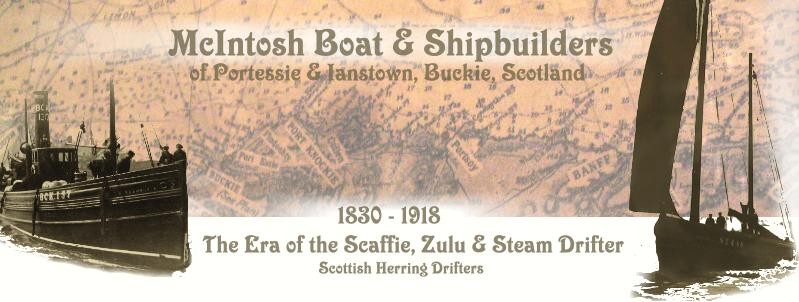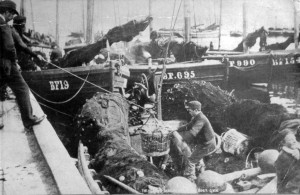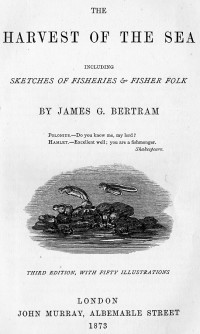
View this page at 1024x768 This page last updated Jan 2008. Unfortunately very little information has survived about any individual McIntosh built scaffies as the last were probably built in the 1880's. One certainty however is that they built many, & the quality of their craft was highly regarded. Please contact me for comment or if you can help with extra information.
Find out more about
And also the Mesothelioma Fund
|
John McIntosh left Cullen after having served his apprenticeship with boatbuilder James Ross, & began building Scaffies at the fishing station of Portessie probably in the late 1820's. He had married in Cullen in 1818 & all his five children were born there, the last being Isabella in 1827.
"Two distinct types of boats were to be found in Scottish waters. The typical herring lugger was the Buckie boat, variously called a scaffie, scaffa, or scaith. Length of keel was 32ft to 33ft, but a curved stem and a sternpost raking at 45deg increased the overall length to 41ft, beam was 13ft, and depth 4ft 9in. The clinker-built hull was lightly constucted of 1 1/2in larch planking with oak ribs, keel, stem and sternpost, and the boat was coated with a crude varnish. As the hull only weighed three tons, it could easily be hauled up a beach. Draught light was, for'ard 2ft 6in, aft 2ft 9in, but with a loaded displacement of 16 tons, the boat drew 4ft 3in for'ard, and 4ft 9in aft, a ton of ballast being carried."
These boats cost £60 fully rigged, had a crew of five, and while most carried two lugsails, some had three.
"The lines of such a boat can be seen - - (here), - - and the inset of the harbour emphasises the dangers of running for such a tiny shelter, surrounded by jagged reefs on all sides, except for the narrow entrance. Many of these scaffies were built by J. & W. McIntosh, of Portessie, a firm of high repute down to the last days of sail."
Check out this picture of a Scaffie unloading, with Scaffies as a back drop. This pic is one of a collection being shared on another site by an 'ally' from Findochty, whose father has a LARGE collection. Probably the best online pic relating to Scaffies, and the best online collection of old herring drifters.

|
Again a quote from 'Sailing Drifters' - Mr. William McIntosh, of Buckie, read his obituary replied in February, 1949, that when he was born some seventy years ago his father, grandfather, and uncle were in company, building scaffies prior to 1880 with a length of keel of about 32ft., the stem was curved and had a 7ft. rake off plumb, and a straight sternpost was about 10ft. off plumb. Hulls were clinker-built, the timbers or frames being fitted after the planking was completed. For hauling in the bush or springrope attached to the nets a winch - the 'ironman'- fitted with handles, stood aft of the mizzen mast." (See the ironman with a handle in the photo of 'JANE ANN' above).
As these dimensions of the last of the McIntosh built scaffies differ little from those in the Washington Report some 30 years previous, it appears the main changes were in the introduction of watertight bulkheads and decking. The manual capstan had been introduced in the 1850's and most likely was the patent capstan, as the reference to handles indicates. Again from 'Sailing Drifters'.
'The conical capstan, turned by men tramping round and round, was being replaced in many drifters by a patent capstan worked by two handles acting on a rack and pinion fitted either to the top of the spindle or to an iron standard alongside.'
|
|
For a most basic description, the Scaffie left the harbour, hythe or beach in the late afternoon, sailed or rowed to the fishing ground & cast out a mile or so of nets which it moored too overnight. The nets were pulled at dawn & 'redded' of the fish as they were pulled aboard, then all haste was made for home to deliver them as fresh as possible to the buyer. This may have required rowing if there was little or an unfavourable wind to sail home. 'A drift-net is an instrument made of fine twine worked into a series of squares, each of which is an inch, so as to allow plenty of room for the escape of young herrings. Nets for herring are measured by the barrel-bulk, and each barrel will hold two nets, each net being fifty yards long and thirty-two feet deep. The larger fishing-boats carry something like a mile of these nets; some, at any rate, carry a drift which will extend two thousand yards in length. These drifts are composed of many separate nets, fastened together by means of what is called a back-rope, and each separate net of the series is marked off by a buoy or bladder which is attached to it, the whole being sunk in the sea by means of a leaden or other weight, and fastened to the boat by a longer or shorter trail-rope, according to the depth in the water at which it is expected to find the herrings. This formidable apparatus, which forms a great perforated wall, being let into the sea immediately after sunset, floats or drifts with the tide, so as to afford the herring an opportunity of striking against it, and so becoming captured - in fact they are drowned in the nets.' |

Click the pic for Chapter 9. |
|
This interesting old fisherman went to sea in a boat called Mowats as a 'scummer' in 1875 at the age of ten, his job to catch the fish which escaped from the nets as they were being hauled, using an iron-hooped net rather like a gigantic butterfly net. He had no pay, but received 'scum money', the worth of the herring which he scummed out of the water. - - - - A few open boats were still in use at the time, but the majority were decked scaffies, some with three masts, which went to sea every evening, returning next morning. The boats were hired by the curers for a complement of 200 cran, and when this mark was reached they had to stop fishing. His shortest time to reach this complement was nine trips. They fished with nets kept upright in the water by a cork rope and stones tied to the footrope, the 'gales' or sides being laced together to form a 'fleet' of 40 to 45 nets, the 'trail end' marked with a small coloured buoy. Each net was 60 yards long, mounted on a rope several yards shorter, with lines called 'ozels', costing fully mounted, 25s. The 'heid back' or warp, by which the nets were connected, was supported by buoys made from sheepskins. Nets were barked before and once during season, using about one hundredweight of bark at a time. The nets were shot on the starboard side, about half a mile from the nearest boat, when all were out the foremast was lowered back into the crutch, the mizzen removed altogether, and laid up on the foredeck, the rudder was brought inboard, and the boat lay to her nets. The fleet was hauled by hand over the stern, on both sides as tide permitted, and the nets were cleared at sea, a process known locally as 'reddin the nets'.' |
|
James Clarke Hook (Tate Gallery) (click the pic for more info on James Clarke Hook)
This painting shows Scaffies returning from fishing to 'Crooked Hythe', Findochty. The harbour was constructed in 1882 - 1883 nearby, off to the left of the painting. |
 |
|
|
|
Mr. Ron Stewart "Sail & Steam" Moray District Library Banffshire Advertiser 'Sailing Drifters' Edgar March Mike & Eileen McKeag US Library of Congress Scran online resource |